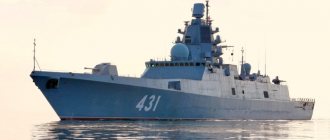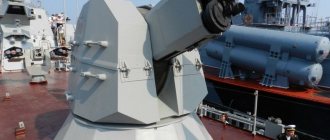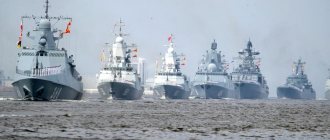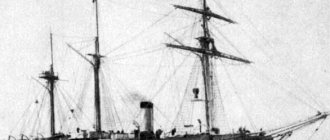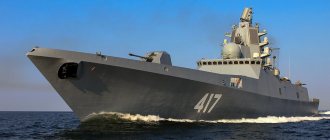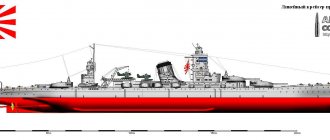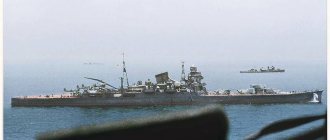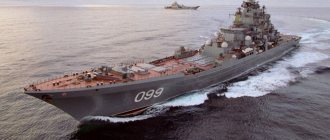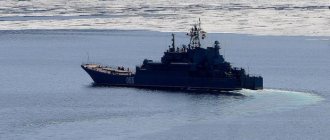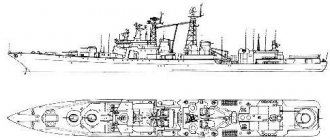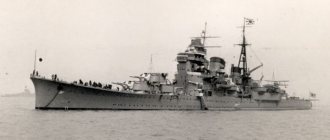Fleet history
The Baltic Fleet is one of the most ancient naval formations. The Baltic Sea, starting from the 10th century, had the most important strategic importance, because it was from here that the so-called path “from the Varangians to the Greeks” began.
The history of the Baltic Fleet can be considered from the beginning of the era of the Novgorod-Swedish wars, although the official date of the creation of a separate unit dates back several centuries later.
The official year of creation of the unification of naval forces in the Baltic Sea is considered to be 1703, but the fleet itself appeared much earlier.
Creation
The Baltic Fleet owes its existence to Peter I. At the end of the 17th century, the last Tsar of All Rus' created a flotilla on the territory of the Yaroslavl region. Around 1696, large-scale construction of ships began at Voronezh shipyards. It was with these ships that the history of the Baltic Fleet would begin a few years later.
The scale of construction is amazing: Austrian engineers were invited to help in construction, and more than 25 thousand peasants and townspeople took direct part in the process. During the well-coordinated work, it was possible to build two large ships, more than 20 galleys and almost one and a half thousand barges designed for transporting people and large cargo.
In those days, only Pyotr Alekseevich was able to understand and evaluate all the prospects for the development of maritime affairs in Russia
The goal of construction is to be in time for the Second Azov Campaign. It was successfully achieved, because already in the middle of 1696, with the support of the built ships, the Azov fortress was captured. This year is the actual date of birth of the navy.
The Baltic Fleet as a separate unit appeared in 1703, during the Northern (Twenty Years) War between the Swedes and a coalition of states in northern Europe, which was fought for the right to own the Baltic lands.
During this period, the Baltic Fleet took part in several military operations, which played an important role in the events of the Northern War.
The period after the death of Peter I
The Navy of Peter I, subsequently transformed into the naval forces of the Russian Empire, noticeably slowed down the speed of development after the death of the Tsar. This also affected the Baltic Fleet. In the period from 1726 to 1730, not a single ship was built; a few years earlier, only one battleship of the line was created.
In 1728, the Swedish ambassador to Russia wrote in reports to his leadership that the fleet was declining and, despite its rapid development earlier, was going through hard times during this period. The old ships were out of order, only a few combat-ready ships remained in working order, and the construction of new ones was suspended.
“Russia needs ocean-going ships - cruisers, frigates, aircraft carriers”
By order of Putin, the construction of ships for the Russian Navy will begin at three shipyards. Two near-sea zone ships and four new submarines, including two nuclear-powered missile carriers, will be built at JSC Admiralty Shipyards in St. Petersburg, in Severodvinsk at JSC Sevmash and at PJSC Amur Shipyard in Komsomolsk-on-Amur .
"Battle for the Arctic". What Moscow and the USA did not share in the North
Back in August, Defense Minister Sergei Shoigu announced the “increased development” of the military...
02 January 19:27
Currently, the construction of Project 955A Borei-A ballistic missile submarines, Project 885M Yasen-M and Project 636.3 Varshavyanka multi-purpose submarines, and Project 20380 (20385) Steregushchiy-class multi-purpose corvettes continues.
“There are enough problems in the Navy. But the adopted development program is being implemented - both in terms of ship composition, and most importantly - in terms of the latest types of weapons. This is an absolute positive. Today we have a fleet that is capable of ensuring security directly off the Russian coast - definitely. The Navy today responds to current threats. I would like the ships to be built faster and larger, but this is a question of the country’s economic capabilities,” Admiral Viktor Fedorov, commander of the Pacific Fleet in 2001–2007, told Gazeta.Ru.
Earlier it was reported that the shipyard was completing work on the transfer of two nuclear submarines to the Russian Navy - in 2022 it will be replenished by the strategic missile carrier Generalissimo Suvorov, the sixth ship of Project 955A Borei-A and the third, being built according to the modernized Project 955A (09552), and the nuclear attack submarine Krasnoyarsk, the fourth ship of Project 885M Yasen-M.
In August, Russian Defense Minister Sergei Shoigu said that by the end of the year the Northern Fleet would receive 238 units of new weapons. According to him, “new ships are being tested, including the nuclear submarines Prince Oleg, Novosibirsk and Belgorod, and a ship-based missile system with the Zircon hypersonic cruise missile, which will soon enter service with the Navy.”
In October, the Ministry of Defense announced the first two test launches of Zircon from the Project 885 Severodvinsk submarine - from surface and submerged positions. It was noted that
the submarine's missile control system and the missile itself operated as normal without any problems. According to the Ministry of Defense, the test goals were achieved - the underwater launch of the missile was worked out and confirmed.
According to the deputy director of the Institute of Political and Military Analysis, Alexander Khramchikhin, despite the development of the shipbuilding industry and the successful implementation of plans to modernize the Russian Navy, it remains “the most problematic area for objective reasons.”
“The fleet takes the longest to build and is the most expensive. In Russia, things are not very good with shipbuilding production capacities; it is in this area that we have lost a lot - large ship factories remained in Ukraine. More ships are now being retired than are being built, and this is difficult to compensate for. The situation in different fleets is different,” the expert said.
According to Khramchikhin, compared to other fleets, “the Pacific Fleet (PF) is in distress.”
“The Pacific Fleet is too large an operational zone, and the current composition of forces is not enough to provide a full-fledged solution to problems, primarily in the far ocean zone. But this is a matter of the near future, when new ships of the far sea zone will arrive at the Pacific Fleet, and submarine forces will also be built up. In the coastal zone, the Pacific Fleet solves its problems; it is capable of ensuring the economic activity of both the fishing industry and all Russian oil and gas enterprises in this economic zone,” Fedorov noted.
“Finally we have reached the point where we can defeat the Swedes”
At the beginning of the 18th century there was a Northern War between Russia and Sweden. At the end of December 1701...
December 31 12:43
Earlier, the commander of the Pacific Fleet, Admiral Sergei Avakyants, said in an interview with the Krasnaya Zvezda newspaper that the corvettes “Perfect”, “Gromky” and “Hero of the Russian Federation Aldar Tsydenzhapov” showed success in missile firing with the Redut anti-aircraft missile system against Malachite target missiles. in the Sea of Japan. Also, the Pacific Fleet Marine Corps was one of the first in the Russian Navy to master the latest BMP-3 infantry fighting vehicles of the naval modification.
“The third Project 636.3 diesel submarine Magadan recently joined the Pacific Fleet. We are waiting for her at her home base in 2022, after completing the inter-fleet transition from the Baltic Fleet, where she is currently located. Also in 2022, the fourth submarine of this project, the Ufa, will join the fleet. Quite recently in Vladivostok, the fourth corvette of Project 20380 “Rezkiy”, built at the Amur Shipyard, was launched from a transport dock for the Pacific Fleet. At the same plant in August of this year, the keel of the Project 20380 Grozny corvettes and the Project 20385 Buiny corvette were laid down. In September, the sixth corvette of Project 20380 “Bravey” was laid down for the Pacific Fleet,” Avakyants said.
Currently, four small Project 22800 missile ships “Rzhev”, “Udomlya”, “Ussuriysk” and “Pavlovsk” are being built for the Pacific Fleet in Komsomolsk-on-Amur; it is planned to modernize the large anti-submarine ship “Admiral Vinogradov” of Project 1155.
Speaking about the Black Sea Fleet (BSF), military expert Viktor Litovkin noted the importance of its current strengthening against the background of the aggravated military-political situation in the region. This year, the United States and its NATO allies have increased their activity in the Black Sea.
According to Litovkin, the big disadvantage of the Navy is that “large shipyards are not being built or their construction is proceeding slowly.”
“Russia needs factories for large-capacity ships; it cannot only own a coastal fleet. She needs to create ocean ships - cruisers, frigates, and prepare the ground for the construction of aircraft carriers. Aircraft carriers are needed.
It’s time to decide which ones - with a nuclear power plant or a gas turbine, with a catapult or a springboard,” the expert said.
Litovkin emphasized that the Navy is not only ships. “This includes the coast, aviation, air defense and missile defense systems. The Navy also includes bases in various areas of the world's oceans. This is also a powerful rear capable of providing the fleet with everything it needs. When the Russian Navy develops as a complex, then it will be invincible,” Litovkin believes.
Fleet basing and missions
Having studied history, you should figure out where the Baltic Fleet was and is today. The headquarters of the Baltic Fleet is located in the city of Kaliningrad. It includes the Red Banner Baltic Naval Base. The Red Banner Leningrad naval base, marked during the Second World War, has three locations - Lomonosov, Kronstadt, St. Petersburg.
Having figured out which bases are part of the Baltic Fleet and where they are located, you should study the ship composition of the Baltic Fleet of the Russian Navy and the composition of military units. The structure of the maritime organization of the Baltic Fleet of the Russian Navy is represented by more than 25 thousand people - the main composition of military or military units.
Destroyers of the Baltic Fleet
The ship “Persistent” began to be built back in the eighties of the last century;
Today it sails under the hull number “610.” The Baltic Fleet of the Russian Navy has the destroyer “Nastoichivy” (project 956). Just 10 years ago there were two such destroyers. The second one is called “Restless”. However, in 2008, the ship was launched for the last time, as it had exhausted its potential. Several years ago the ship became a museum exhibit.
Baltic Fleet of the Russian Federation
The Baltic Fleet of the Russian Navy is the operational-strategic formation of the Navy in the Baltic Sea. The main bases are Kaliningrad and Leningrad regions. It includes a formation of surface ships, a division of diesel submarines, formations of auxiliary and search and rescue vessels, naval aviation, coastal troops, air defense units, as well as rear technical and special support. The flagship of the Baltic Fleet is the Project 956 destroyer Nastoychivy.
Baltic Fleet Command
Baltic Fleet Command
Nosatov Alexander Mikhailovich Commander of the Baltic Fleet, Admiral
March 30, 2022 The new Smerch multiple launch rocket systems entered service with the artillery unit of the Baltic Fleet army corps in the Kaliningrad region. The new equipment was supplied as part of the planned rearmament of troops with modern types of weapons and military equipment. The personnel, as part of the planned camp gathering of the missile forces and artillery of the army corps, began mastering the Smerch MLRS at the training ground.
On November 16, 2022, a detachment of ships of the Baltic Fleet, consisting of the patrol vessel Yaroslav the Mudry, the tugboat Viktor Konetsky and the tanker Yelnya, entered the Syrian port of Tartus for the second time during a long voyage. The day before, the ships completed a number of combat training missions in the Mediterranean Sea, during which they conducted training in the use of air defense and electronic warfare systems. In addition, the crews practiced searching for mock enemy submarines and conducted electronic missile launches against sea targets with the Uran anti-ship missile system.
On March 26, 1966, at the berths of Krasheninnikov Bay, Kamchatka Territory, the round-the-world voyage of Soviet nuclear submarines of Project 627A with the operational-tactical number K-133 and Project 675 with the number K-116 ended. The successful completion of a unique voyage is a wonderful page in the history of the Russian submarine fleet. Domestic science has created reliable warships that could solve any problems in the World Ocean.
On January 30, 1945, the crew of the Soviet submarine S-13 under the command of Captain 3rd Rank Alexander Marinesko sank the German passenger superliner, used as a warship, Wilhelm Gustloff in the Danzig Bay area. As a result, between 5,300 and 9,500 people died. A Soviet submarine attacked and sent to the bottom a ship of the German navy, on which there were 10,582 Germans: 1,626 military personnel - 918 junior group cadets of the 2nd submarine training division, 173 crew members, 373 women from the naval corps, 162 wounded military personnel and 8,956 civilians.
On March 15, 1919, by Order No. 117, the Petrograd Naval Base was created on the basis of the Petrograd Naval Forces. It was led by military sailor Alexander Spolatbog. The first detachment of warships included three battleships, three cruisers, destroyers and five yachts. The base was entrusted with responsibility for the deployment of ships and vessels, as well as taking measures to defend the city from sea directions.
On February 2, 1701, Realizing the need for the Russian fleet in the Baltic Sea to protect the state and strengthen its power, Peter the Great issued a Decree in which he ordered the construction of six 18-gun ships to begin on Lake Ladoga. Thus, the beginning of the Russian Baltic Fleet was laid, the main base of which was located in Kronstadt.
